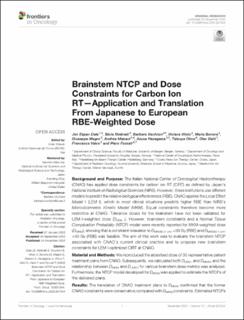| dc.description.abstract | Background and Purpose: The Italian National Center of Oncological Hadrontherapy (CNAO) has applied dose constraints for carbon ion RT (CIRT) as defined by Japan’s National Institute of Radiological Sciences (NIRS). However, these institutions use different models to predict the relative biological effectiveness (RBE). CNAO applies the Local Effect Model I (LEM I), which in most clinical situations predicts higher RBE than NIRS’s Microdosimetric Kinetic Model (MKM). Equal constraints therefore become more restrictive at CNAO. Tolerance doses for the brainstem have not been validated for LEM I-weighted dose (DLEM I). However, brainstem constraints and a Normal Tissue Complication Probability (NTCP) model were recently reported for MKM-weighted dose (DMKM), showing that a constraint relaxation to DMKM|0.7 cm3 <30 Gy (RBE) and DMKM|0.1 cm3 <40 Gy (RBE) was feasible. The aim of this work was to evaluate the brainstem NTCP associated with CNAO’s current clinical practice and to propose new brainstem constraints for LEM I-optimized CIRT at CNAO.
Material and Methods: We reproduced the absorbed dose of 30 representative patient treatment plans from CNAO. Subsequently, we calculated both DLEM I and DMKM, and the relationship between DMKM and DLEM I for various brainstem dose metrics was analyzed. Furthermore, the NTCP model developed for DMKM was applied to estimate the NTCPs of the delivered plans.
Results: The translation of CNAO treatment plans to DMKM confirmed that the former CNAO constraints were conservative compared with DMKM constraints. Estimated NTCPs were 0% for all but one case, in which the NTCP was 2%. The relationship DMKM/DLEM I could be described by a quadratic regression model which revealed that the validated DMKM constraints corresponded to DLEM I|0.7 cm3 <41 Gy (RBE) (95% CI, 38–44 Gy (RBE)) and DLEM I|0.1 cm3 <49 Gy (RBE) (95% CI, 46–52 Gy (RBE)).
Conclusion: Our study demonstrates that RBE-weighted dose translation is of crucial importance in order to exchange experience and thus harmonize CIRT treatments globally. To mitigate uncertainties involved, we propose to use the lower bound of the 95% CI of the translation estimates, i.e., DLEM I|0.7 cm3 <38 Gy (RBE) and DLEM I|0.1 cm3 <46 Gy (RBE) as brainstem dose constraints for 16 fraction CIRT treatments optimized with LEM I. | en_US |

